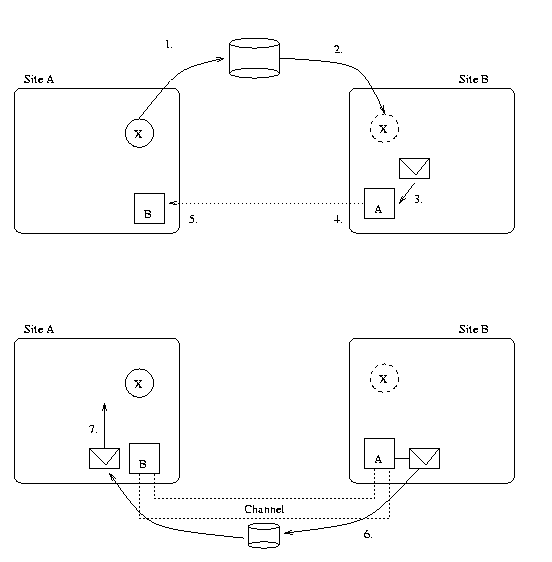2 Connection Establishment
When a Mozart site is a participant in a distributed computation, entities are automatically distributed via lexical scoping and connections are opened when needed. Before this can take place an initial entry point in the distributed application must exist. This is what we refer to as bootstrapping a connection.
2.1 Bootstrapping a Connection
The Mozart programmer establishes connections to the outside world by offering a ticket to an entity. Such a ticket is an character string containing enough information for other Mozart sites to connect to the offering site and access the offered entity. This connection establishment procedure is illustrated in Figure 2.1.
Site
Aoffers a ticket to entity X and saves the string to persistent storage available to B.Site
Bloads the string and takes this ticket which will cause a representation of siteAand a representation of X to be created at B.Site
Bcreates a message requesting access to X and passes the message down to the representation ofA.A connection to
Ais requested from the connect-accept-module.At site
Aan incoming request for a connection is accepted. During a hand-shake phase the representation ofBis passed toA.Site
Bmarshals the message and sends it toA.Site
Aunmarshals the message and passes it to the appropriate protocol message handler.
2.2 Dynamic Connection Establishment through Connect-Accept-Pairs
How a message is transferred between two sites, and how a physical connection is initialized is of no importance to the semantics of entities. However, this is of great importance when it comes to communicating over different types of networks with different restrictions such as security requirements or firewalls. Mozart offers a default connect-accept-module with non-secure initialization of a connection over TCP, but the interfaces are open for the programmer to customize parts or all of the procedure. This is possible through the notion of Connect-Accept-Pairs and the three layer design, allowing for replacement of the transport layer.
Connect-Accept-Pairs
To define how a physical connection is initialized, a pair consisting of a connection and an accept procedure can be customly defined. The accept procedure defines how a site accepts incoming requests for connections and runs locally at that specific site. The connection and accept procedure must agree on a scheme to establish a connection, and the connection procedure should in the future be possible to pass around with any reference to the site. Currently an application programmer can create a custom pair and manually install it in all processes involved in a distributed application. This will create a subdomain only accessible to those processes.
Transport Modules
A transport module is responsible of delivering messages from one site to another. It may be a very lean layer interfacing TCP or contain a complete implementation of a new transport protocol.
2.3 Automatic Connection Opening and Closing
For efficiency reasons, physical connections should be open while there is a need for them from at least one end, and there are enough resources to maintain them. To achieve this, connections are automatically established when the need arises and closed when the need no longer remains. The latter part is handled by the garbage collector; once the last reference is garbage collected locally, the connection will be closed. When resources are low, connections will be taken down temporarily.
